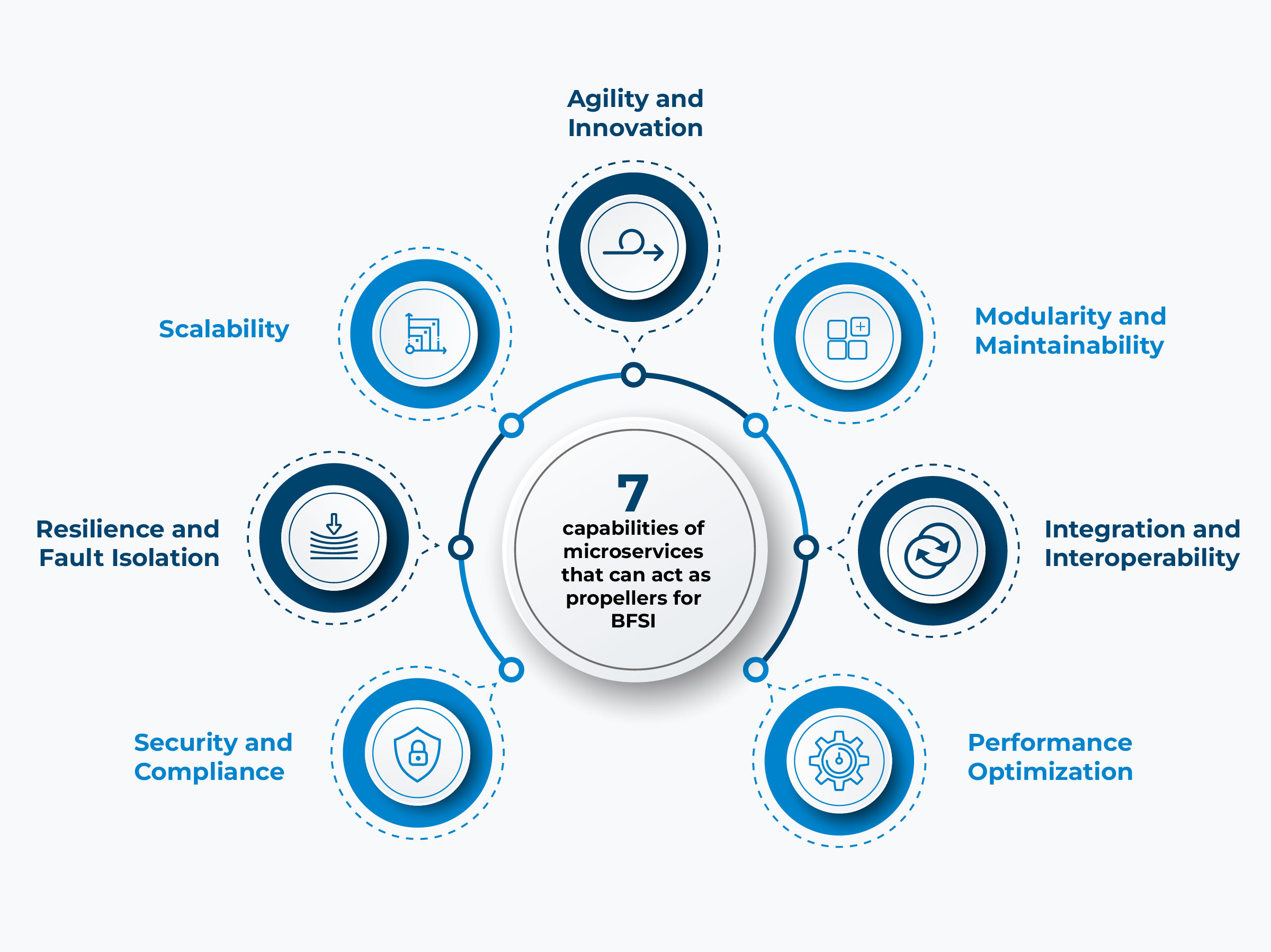

Blog

Home »
How Microservices Can Act as Propellers for BFSI
Reading Time: 5 minutes
Microservices-based architecture can help the Banking Financial Services and Insurance industry expedite its digital transformation efforts helping drive scalability, agility, and security besides powering integration, modularity, maintainability, performance, and resilience.
Digital transformation has become an unavoidable urgent mandate for BFSI owing to the changing market dynamics and preferences. Legacy systems and monolithic architectures have often dragged down financial institutions in a rapidly evolving business environment. Here, microservices perfectly fit the bill to empower BFSI with new-age capabilities that help them stand out and revel in a competitive landscape.
7 capabilities of microservices that can act as propellers for BFSI
BFSI is a complex maze of interlinked offerings and functions. The sheer volume of offerings and accompanying functionalities interweaved together can be precarious to handle. Microservices remove the complexity by decoupling functionalities and presenting them as individual functions incurring multiple benefits to both providers and users. Below are some advantages of embracing a microservices architecture in the BFSI industry.
 7 capabilities of microservices that can propel BFSI
7 capabilities of microservices that can propel BFSI
Agility and Innovation:
Agility and Innovation are crucial pillars for any modern-day business to thrive. It is the same for the highly competitive BFSI industry. Microservices allow financial organizations to adopt an agile approach to software development. Since each microservice is decoupled and can be developed independently, it allows developers to work on different services simultaneously, significantly improving development timelines. This agility provides financial institutions to quickly respond to market demand, launch new products and services, and experiment with innovative features.
Scalability:
Financial institutions are constantly on the lookout for expansion, offering new, improved products and services. As microservices are separate functions or applications it enables institutions to scale strategically by concentrating on scaling specific microservices as per demand and need. This flexibility enables banks to handle increasing transaction volumes and user loads without affecting the entire system.
Modularity and Maintainability:
Banking and financial systems are usually complex and can be tough to manage if interlinked and interdependent on one another. Embracing microservices can help decouple these systems into smaller, manageable components. As microservices are smaller components focused on a specific function it becomes easier to understand, develop, and maintain them. This modularity can help financial institutions to attend to specific functions, improving and attending to fixes quickly instead of looking at the entire application.
Resilience and Fault Isolation:
Since microservices are decoupled and not conjoined into one single system or function, fault detection, isolation, and remedy can be carried out without disturbing the entire system. This feature of microservices enabling fault isolation also ensures that other microservices can continue functioning independently, ensuring the overall resilience of the banking application.
Integration and Interoperability:
With microservices standing out as distinct functions it becomes easy for businesses to design, develop and execute frameworks for easy integration and interoperability. Each microservice can expose well-defined APIs, enabling different systems to communicate and share data more efficiently. This flexibility allows financial institutions to integrate new services or connect with external partners more easily.
Security and Compliance:
Microservices can play a key role in BFSI security and compliance by helping separate sensitive components into dedicated microservices. By integrating microservices into the scheme of things financial institutions can implement different security measures and access controls based on the specific requirements of each service. This defined security approach helps protect critical banking operations and customer data, besides ensuring compliance with prevailing industry regulations.
Performance Optimization:
As microservices help financial institutions to serve a variety of functions separately, it also gives them the scope to choose the most appropriate technology stack for each microservice. By selecting specialized frameworks, databases, or programming languages that are best suited for specific functionalities financial institutions can drive desired performance and efficiency across selected functions.
Embrace microservices to drive digital transformation in a digital-first world
Legacy systems heavily relying on monolithic architecture are passe in a rapidly digitizing world. Digitization and digitalization are imperatives that need immediate addressing both at the front end to drive engagement with customers as well as the back end to drive efficiencies for the enterprise. As per a survey carried out by Forrestor and Ipsos, 4 out of 10 customers now have an account with an online bank. The survey further highlights that 36% consult their banking app at least once a day and an even higher proportion, 58%, look at it as their preferred method of dealing with their bank. Statistics clearly indicate the inclination of customers to digitally conduct business with financial institutions of their choice. It is here that the integration of modern architecture powered by microservices can significantly empower financial institutions to improve and improvise their digital capabilities to meet the changing requirements of business and customers.
Innover’s Financial Services encompass retail banking, payments, asset and wealth management, capital markets, and insurance. Our unparalleled prowess and integrated approach combine advanced analytics, digital experiences, and digital operations, empowering organizations in the Banking Financial Services, and Insurance industries to design, develop, and execute customized digital products and solutions that positively impact operational efficiencies, customer engagement, and revenue streams.

